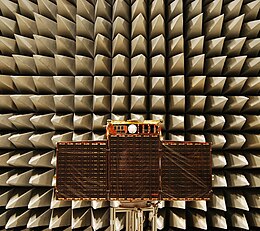|
TET-1
TET-1 (German: Technologieerprobungsträger 1, Technology Experiment Carrier) was a microsatellite operated by the German Space Operations Center of the German Aerospace Center. It was the centre of the OOV (On Orbit Verification) Program, initiated to offer on-orbit verification possibilities to the German industrial and scientific aerospace community.[2] TET was based on the satellite bus used for the BIRD satellite, which was launched in 2001.[3] The main contractor for Phase A (feasibility) was IABG. The final contract for Phases B, C, and D (definition/qualification, and production) and start was given to Kayser-Threde GmbH, a medium-sized aerospace company based in Munich belonging to the German OHB-System group. The environmental qualification was successfully conducted in the IABG space simulation centre in Munich. TET-1 was carried to orbit as a secondary payload on a Soyuz-FG/Fregat carrier rocket which was launched from the Baikonur Cosmodrome on 22 July 2012.[1] The primary payload of the launch was the Kanopus-V1 satellite, with the BelKA-2, Zond-PP and exactView-1 satellites also flying on the same rocket. After 10 years in orbit, the TET-1 satellite re-entered into the atmosphere on 18 November 2022.[4] References
External linksInformation related to TET-1 |
||||||||||||||||||||||||||||||||||||||||||||||||
Portal di Ensiklopedia Dunia
